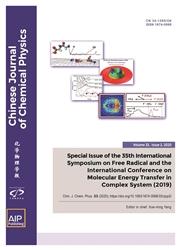Atomistic mechanisms for catalytic transformations of NO to NH3, N2O, and N2 by Pd
IF 1.2
4区 化学
Q4 PHYSICS, ATOMIC, MOLECULAR & CHEMICAL
引用次数: 0
Abstract
The industrial pollutant NO is a potential threat to the environment and to human health. Thus, selective catalytic reduction of NO into harmless N2, NH3, and/or N2O gas is of great interest. Among many catalysts, metal Pd has been demonstrated to be most efficient for selectivity of reducing NO to N2. However, the reduction mechanism of NO on Pd, especially the route of N−N bond formation, remains unclear, impeding the development of new, improved catalysts. We report here the elementary reaction steps in the reaction pathway of reducing NO to NH3, N2O, and N2, based on density functional theory (DFT)-based quantum mechanics calculations. We show that the formation of N2O proceeds through an Eley-Rideal (E−R) reaction pathway that couples one adsorbed NO* with one non−adsorbed NO from the solvent or gas phase. This reaction requires high NO* surface coverage, leading first to the formation of the trans-(NO)2* intermediate with a low N−N coupling barrier (0.58 eV). Notably, trans-(NO)2* will continue to react with NO in the solvent to form N2O, that has not been reported. With the consumption of NO and the formation of N2O* in the solvent, the Langmuir-Hinshelwood (L-H) mechanism will dominate at this time, and N2O* will be reduced by hydrogenation at a low chemical barrier (0.42 eV) to form N2. In contrast, NH3 is completely formed by the L-H reaction, which has a higher chemical barrier (0.87 eV). Our predicted E-R reaction has not previously been reported, but it explains some existing experimental observations. In addition, we examine how catalyst activity might be improved by doping a single metal atom (M) at the NO* adsorption site to form M/Pd and show its influence on the barrier for forming the N−N bond to provide control over the product distribution.Pd催化NO转化为NH3、N2O和N2的原子机制
工业污染物NO对环境和人类健康构成潜在威胁。因此,将NO选择性催化还原为无害的N2、NH3和/或N2O气体是非常令人感兴趣的。在许多催化剂中,金属Pd已被证明对将NO还原为N2的选择性最有效。然而,NO在Pd上的还原机制,特别是N−N键的形成途径,仍不清楚,阻碍了新型改进催化剂的开发。我们在此报道了基于密度泛函理论(DFT)的量子力学计算,将NO还原为NH3、N2O和N2的反应途径中的基本反应步骤。我们表明,N2O的形成是通过Eley-Rideal(E−R)反应途径进行的,该反应途径将溶剂或气相中的一个吸附的NO*与一个未吸附的NO偶联。该反应需要高NO*表面覆盖率,首先导致形成具有低N−N耦合势垒(0.58eV)的反式-(NO)2*中间体。值得注意的是,反式-(NO)2*将继续与溶剂中的NO反应形成N2O,这一点尚未报道。随着NO的消耗和N2O*在溶剂中的形成,此时Langmuir Hinshelwood(L-H)机制将占主导地位,N2O*将通过在低化学势垒(0.42eV)下的氢化而还原,形成N2。相反,NH3完全由L-H反应形成,其具有更高的化学势垒(0.87eV)。我们预测的E-R反应以前没有报道过,但它解释了一些现有的实验观察结果。此外,我们研究了如何通过在NO*吸附位点掺杂单个金属原子(M)以形成M/Pd来提高催化剂活性,并展示了其对形成N−N键的势垒的影响,以控制产物分布。
本文章由计算机程序翻译,如有差异,请以英文原文为准。
求助全文
约1分钟内获得全文
求助全文
来源期刊

Chinese Journal of Chemical Physics
物理-物理:原子、分子和化学物理
CiteScore
1.90
自引率
10.00%
发文量
2763
审稿时长
3 months
期刊介绍:
Chinese Journal of Chemical Physics (CJCP) aims to bridge atomic and molecular level research in broad scope for disciplines in chemistry, physics, material science and life sciences, including the following:
Theoretical Methods, Algorithms, Statistical and Quantum Chemistry
Gas Phase Dynamics and Structure: Spectroscopy, Molecular Interactions, Scattering, Photochemistry
Condensed Phase Dynamics, Structure, and Thermodynamics: Spectroscopy, Reactions, and Relaxation Processes
Surfaces, Interfaces, Single Molecules, Materials and Nanosciences
Polymers, Biopolymers, and Complex Systems
Other related topics
 求助内容:
求助内容: 应助结果提醒方式:
应助结果提醒方式:


